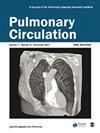Glenn Edward Malcolm Reeves, Julie Shepherd, Nicholas John Collins, Scott Twaddell, Rajinder Harjit Singh
下载PDF
{"title":"Assessing quality of life in pulmonary arterial hypertension: An independent prognostic marker.","authors":"Glenn Edward Malcolm Reeves, Julie Shepherd, Nicholas John Collins, Scott Twaddell, Rajinder Harjit Singh","doi":"10.1002/pul2.12380","DOIUrl":null,"url":null,"abstract":"<p><p>Pulmonary arterial hypertension (PAH, or PH Group 1), a disease of aberrant pulmonary vascular remodeling, causing progressive right heart failure (RHF) due to elevation of pulmonary vascular resistance (PVR). Patient mortality risk stratification guides choice and intensity of pharmacological intervention and is assessed by haemodynamics (especially PVR) as well as noninvasive tools including WHO functional class (FC), 6-min walk distance (6MWD), and NT-proBNP levels. Quality of life (QOL) assessment is acknowledged as a central aspect of patient-centered care, but our study sought to extend QOL's role as an additional noninvasive risk marker that could further refine risk stratification and hence therapeutic choices within a \"treatment to target\" paradigm (aiming to achieve low-risk status). This study found that QOL assessment using the PAH-SYMPACT© physical activity tool provided enhanced, independent mortality risk information, with one unit rise in this score associated with a 41% increase in likelihood risk (odds ratio 1.41, 95% confidence interval: 1.01-1.98 (<i>p</i> < 0.05)) of falling within intermediate versus low-group category. We therefore found further support for additional prognostic value being conferred by measurement of QOL as part of routine PAH evaluation, reinforcing its critical role.</p>","PeriodicalId":20927,"journal":{"name":"Pulmonary Circulation","volume":"14 2","pages":"e12380"},"PeriodicalIF":2.2000,"publicationDate":"2024-06-02","publicationTypes":"Journal Article","fieldsOfStudy":null,"isOpenAccess":false,"openAccessPdf":"https://www.ncbi.nlm.nih.gov/pmc/articles/PMC11144421/pdf/","citationCount":"0","resultStr":null,"platform":"Semanticscholar","paperid":null,"PeriodicalName":"Pulmonary Circulation","FirstCategoryId":"3","ListUrlMain":"https://doi.org/10.1002/pul2.12380","RegionNum":4,"RegionCategory":"医学","ArticlePicture":[],"TitleCN":null,"AbstractTextCN":null,"PMCID":null,"EPubDate":"2024/4/1 0:00:00","PubModel":"eCollection","JCR":"Q2","JCRName":"CARDIAC & CARDIOVASCULAR SYSTEMS","Score":null,"Total":0}
引用次数: 0
引用
批量引用
Abstract
Pulmonary arterial hypertension (PAH, or PH Group 1), a disease of aberrant pulmonary vascular remodeling, causing progressive right heart failure (RHF) due to elevation of pulmonary vascular resistance (PVR). Patient mortality risk stratification guides choice and intensity of pharmacological intervention and is assessed by haemodynamics (especially PVR) as well as noninvasive tools including WHO functional class (FC), 6-min walk distance (6MWD), and NT-proBNP levels. Quality of life (QOL) assessment is acknowledged as a central aspect of patient-centered care, but our study sought to extend QOL's role as an additional noninvasive risk marker that could further refine risk stratification and hence therapeutic choices within a "treatment to target" paradigm (aiming to achieve low-risk status). This study found that QOL assessment using the PAH-SYMPACT© physical activity tool provided enhanced, independent mortality risk information, with one unit rise in this score associated with a 41% increase in likelihood risk (odds ratio 1.41, 95% confidence interval: 1.01-1.98 (p < 0.05)) of falling within intermediate versus low-group category. We therefore found further support for additional prognostic value being conferred by measurement of QOL as part of routine PAH evaluation, reinforcing its critical role.
评估肺动脉高压患者的生活质量:一个独立的预后指标
肺动脉高压(PAH,或 PH 第一类)是一种肺血管重塑异常的疾病,由于肺血管阻力(PVR)升高而导致进行性右心衰竭(RHF)。患者死亡率风险分层可指导药物干预的选择和强度,并通过血液动力学(尤其是肺血管阻力)以及包括世界卫生组织功能分级(FC)、6 分钟步行距离(6MWD)和 NT-proBNP 水平在内的非侵入性工具进行评估。生活质量(QOL)评估被认为是以患者为中心的医疗服务的一个核心方面,但我们的研究试图将 QOL 的作用扩展为一种额外的无创风险标志物,可进一步完善风险分层,从而在 "目标治疗 "范式(旨在实现低风险状态)中做出治疗选择。这项研究发现,使用 PAH-SYMPACT© 体力活动工具进行 QOL 评估可提供更多独立的死亡风险信息,该评分每上升一个单位,可能性风险就会增加 41%(几率比 1.41,95% 置信区间:1.01-1.98(p
本文章由计算机程序翻译,如有差异,请以英文原文为准。

 求助内容:
求助内容: 应助结果提醒方式:
应助结果提醒方式:


